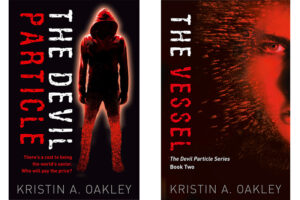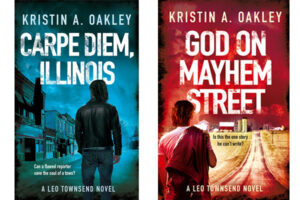In my article Why You Need a Newsletter, I gave six reasons why newsletters are essential for writers. Building relationships with your readers is the number one reason. If you have a strong connection with your fans, not only will they buy your books, they’ll also recommend your books to other readers. Word of mouth is still the number way to sell books.
That’s all well and good, you might say, but I don’t have any fans. Who would I send my newsletter to?
When I started my email list years ago, I simply signed up everyone who was in my address books—paper and electronic. Easy peasy. Now, with the CAN-SPAM Act, you have to ask permission from every potential subscriber before adding them to your email list.
That initial effort gained me 440 subscribers, and over the years, that number rose to 470 and stayed there. But with the release of The Devil Particle Series next spring, I want to expand my email list to 1,000. How?
There are three major ways I’m going to do it, and you can too. Note: If you don’t already have an email marketing service such as MailChimp or Constant Contact, get one before taking these steps. I use MailChimp, which is free at the basic level and easy to use.
Contacting people directly
I’m taking the advice marketing guru Tim Grahl gives to authors just starting their newsletter. Contact each person you know directly and ask them if they’d like to receive your spanking new newsletter. Don’t simply post the question on Facebook; take the time to ask each person individually.
My newsletter was already established when I heard Tim’s advice, so I tweaked my message to fit my situation:
Hi (First Name), Twice a month, I write a newsletter reviewing books and sharing what it’s like to be a novelist. I think you’ll enjoy it. May I add you to my email list? If so, let me know the best email address for you.
If you’re just starting your newsletter, you might want to add that it’s new, include a brief description of the newsletter’s subject, and ask them for their email address. You’ll want to keep a record of when you contacted people and whether they agreed. Be sure to thank them!
Keeping track of contacts
To keep track of who I contacted and whether they signed up, I created an Excel spreadsheet with three columns—first and last name (in that order), date I contacted them (I write IM’d, Email, Twit, or Link before the date to indicate how I contacted them), and the date of reply.
Then when I receive their email address, I write the address right after their name and immediately add it to my MailChimp audience. Finally, I highlight their name and the dates in yellow on the spreadsheet. That way, it’s easy to see who I still need to contact. If the person is not interested in receiving my email, I highlight their information in gray.
Using Facebook
So I went through my 900+ friends on Facebook, cross-referenced their names with my MailChimp audience, including those who were no longer active, and came up with 615 people to contact. Each night for two weeks, I’d put in a good movie and instant messaged everyone on my list.
At first, I was nervous about doing it. I didn’t want to bother people. Then I told myself I had to get over it; people could say no. Once I got started, I was surprised at the number of people who thanked me for asking them. I connected with old friends I hadn’t heard from in years. And those few who weren’t interested were very polite when they declined. Most importantly, I added 220 people to my MailChimp audience.
As you might guess, there were a lot of people who simply didn’t respond. So this past week, I dug out my list and am contacting those people again. Here’s what I say:
Hi (First Name), I’m just following up with you – are you interested in receiving my newsletter? Twice a month, I review books and share what it’s like to be a novelist. I think you’ll enjoy it. May I add you to my email list? If so, let me know the best email address for you. I promise not to bother you a third time!
Because of this, I’ve already added sixteen more names. Once I’ve exhausted my Facebook contacts, I’ll reach out to my 1,500 Twitter followers and my 500 contacts on LinkedIn. It’s time-consuming but easy to do while watching a favorite movie or TV show, and once I’ve reached out to everyone, I’m done.
Sign-up sheet at events
I’ve also added people to my email list by handing out a sign-up sheet at author fairs, book events, book clubs, and workshops I’m presenting. The sign-up sheet includes a column for their name and one for their email address. Generally speaking, I get more people to sign up when they attend one of my workshops, but people who buy my novels are generally interested too.
At the Chicago Writers Association’s Let’s Just Write! An Uncommon Conference last March, I taught a workshop on the importance of critique groups in 2022. I made the mistake of handing out the sheet at the beginning of the session and then asked everyone to get up and move to designated areas based on whether they wrote fiction/memoir, nonfiction, poetry, or short stories and essays.
After the session, I thought about looking for the sheet but figured it was long gone. Plus, I didn’t have time to try and track it down. Later that day, a friend found it and handed it to me with signatures on both the sheet’s front and back. I hoped to get 15 people to sign up and was surprised to see 35 names!
Lead magnet
A lead magnet is something you give away for free in return for the person signing up for your newsletter. This can be a sample of your writing, a first chapter, the first book in a series, tips from your how-to book, or a recipe from your cookbook. Your lead magnet should be digital to avoid shipping costs. For my lead magnet, I send new subscribers the short story which inspired my new series.
Here is my lead magnet offer:
“Sign up for my bi-monthly newsletter and receive a free short story, “The Bomb,” the inspiration behind my soon-to-be-released Devil Particle Series.
I include this lead magnet in the sign-up forms on my website, in my Twitter bio, as a pinned post on my author Facebook page, as the featured item on my LinkedIn, as an Instagram post, and at the end of articles such as this one. I plan on including it in the signature line of all my emails. I post it everywhere.
For six months, I’m giving the short story as my lead magnet a try. After that, I’ll give away my list of my top ten favorite books just in time for the holidays. It’ll be interesting to see which one gains me more subscribers.
To increase your email list and get a greater audience for your newsletters and your books, try contacting people directing, providing a sign-up sheet at in-person events, and offering a lead magnet. You’ll be pleasantly surprised at the results.
Please note: This article was originally published on the September 13, 2022 Chicago Writers Association blog.



